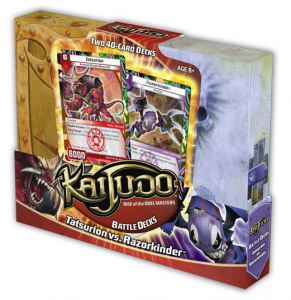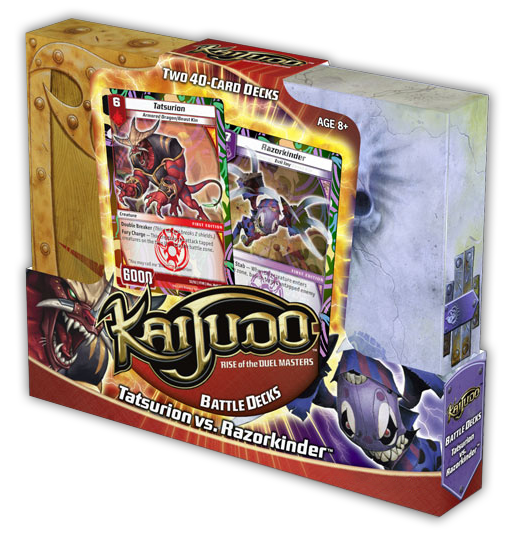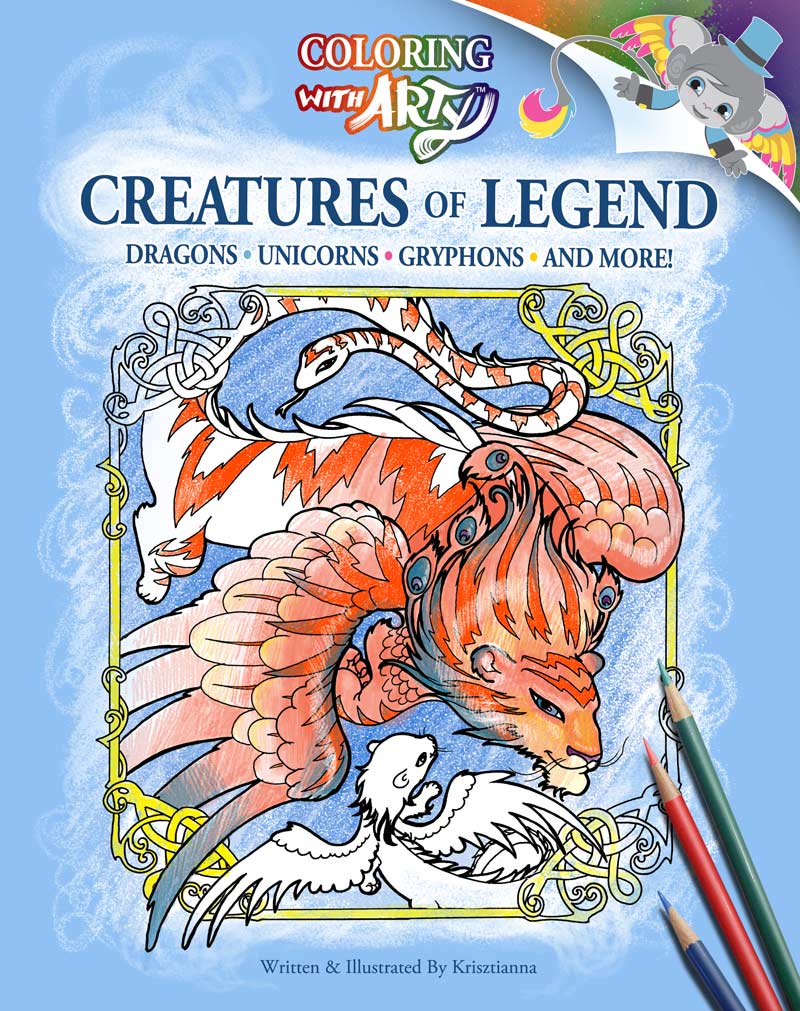Getting Schooled in Kaijudo at Comic-Con
 Game industry leader Wizards of the Coast’s main focus at the 2012 Comic-Con was its release of the trading card game Kaijudo. The card game goes hand in hand with the Kaijudo: Rise of the Duel Masters animated children’s show viewable on The Hub TV network. At the booth, visitors could get their picture taken with one of the cartoon’s characters, try out the online versions of Kaijudo, and play a demo of the game using one of the already-released BattleDecks. As a reward for trying the demo, WotC gave out 9-card Dojo Edition booster packs of the cards, which will go on sale to the general public at gaming outlets on July 24. Wizards will be following up the July Dojo Edition release with a broader release at mass market retailers like Target in September.
Game industry leader Wizards of the Coast’s main focus at the 2012 Comic-Con was its release of the trading card game Kaijudo. The card game goes hand in hand with the Kaijudo: Rise of the Duel Masters animated children’s show viewable on The Hub TV network. At the booth, visitors could get their picture taken with one of the cartoon’s characters, try out the online versions of Kaijudo, and play a demo of the game using one of the already-released BattleDecks. As a reward for trying the demo, WotC gave out 9-card Dojo Edition booster packs of the cards, which will go on sale to the general public at gaming outlets on July 24. Wizards will be following up the July Dojo Edition release with a broader release at mass market retailers like Target in September.
Kaijudo is based on the Duel Masters TCG released by Wizards of the Coast in 2004, but discontinued domestically in 2006. Meanwhile Duel Masters has remained popular in Asia, particularly Japan. Comic-Con had a Kaijudo panel, “The Making of Kaijudo“, focusing on the animated series with voice actors Scott Wolf, David Sobolov, and Ryan Miller attending among others. While I skipped it, I did play through two demos of the game and interviewed the Senior Brand Manager of Kaijudo, Kierin Chase, about the game’s development and immediate future.
I also recorded my second Comic-Con demo of Kaijudo, playing against a friendly (and ruthless) Wizards of the Coast employee:
Initial Thoughts on Kaijudo
Despite its Duel Masters roots, Kaijudo is a separate brand and is being treated as a new product line by Wizards of the Coast, one that has been in development for over two years. Hasbro, which owns WotC, has put a lot of resources behind Kaijudo, most importantly the well-received children’s show. Will Kaijudo be the next big thing for Wizards? I don’t know, but they’re certainly positioning themselves for a hit. For players who missed the starting eras of Magic: The Gathering, Pokemon or Yu-Gi-Oh, I think it can be daunting to get involved as a gamer, especially if you want to play competitively. There are so many cards to learn and/or acquire to be able to play effectively. At present there are only two sets of Kaijudo with the full set of 43 available in the $20 BattleDeck and 55 more cards with the release of the Dojo Edition. Also by having the electronic version of the game available from the start (or even before the main launch), Wizards of the Coast has another way of involving players and educating them on gameplay. No one wants the embarrassment of struggling with a game’s rules or coming off as too much of a newb and playing the computer version online can alleviate that. At the same time, is Kaijudo a truly fresh gaming experience? How many more collectible card games do we need where we summon monsters to battle? Magic: TG, Pokemon, Digimon, and Yu-Gi-Oh all have the same basic game premise. To me there is little novelty in Kaijudo. I am also indifferent to the game’s setting and artwork, but that might change after I watch the Kaijudo television show. No, for me, what sells the game is its low cost of entry and the actual gameplay.
Kaijudo’s Gameplay
For me, with limited experience playing TCGs/CCGs, Kaijudo is a cross between Magic: The Gathering and Pokémon. I have only played Pokémon a few times and the game seemed fairly simplistic; I have much more experience playing Magic in the early ’90s. While there are five colors in Kaijudo, there isn’t Life to keep track of; instead the game uses five Shields represented by regular game cards. Likewise while you do tap mana to summon its creatures, Kaijudo’s power-generation comes from regular cards and not special lands. Instead of attack and defense stats on creatures, there’s only one stat for power and it almost always comes in multiples of 1,000 (one card does have a power of 5500). Wizards of the Coast have boiled down a lot of M:TG concepts and made them very accessible to beginners. I wouldn’t call it Magic Lite, but Magic players will almost instantly grasp Kaijudo’s mechanics. Those unfamiliar with Magic: TG should still have an easy time picking up Kaijudo’s basic concepts. Gameplay is fast, but that could change with blocker-heavy decks. By not allowing creatures to block unless they have the special ability to do so, Kaijudo has a more aggressive tone than Magic. One thing that I absolutely love about Kaijudo is that even when you are losing by having your shields taken out, you still get something in return because the broken shield cards go to your hand.
The Kaijudo Dojo Edition and Battle Decks
At Comic-Con I asked my wife and brother-in-law to also try the game. Asked is putting it nicely. I begged and then harangued them until they had both completed their own demo and then was surprised to find that they had not enjoyed the game as much as I had. Most of this was due to their shared opponent who was not a WotC employee, but a CCG fan who told my brother-in-law, “I could have beaten you sooner, but I enjoy toying with my prey.” The know-it-all also confided to my brother-in-law that he did not want to embarrass him in front of my wife, as though this was any consolation or made him any less annoying than he was. For their troubles, I was able to get two more Dojo Edition booster packs. The 55-card set is divided into 11 cards for each Nation or color.
Inspired by my own enjoyable experiences with Kaijudo, I also picked up a Battle Deck from a local comic book store. Wizards of the Coast was not selling any product at Comic-Con, but had opened a pop-up Magic store in the Gaslamp District, which adjoins the San Diego Convention Center. At only $20, the Battle Deck boxes are quite appealing, giving two players each a deck of 40 cards, a playing mat, and a special code for the online versions of the game. The rules are teeny tiny and by that I don’t mean tons of small print, but instead clear and concise rules that govern most of the game’s interactions.
Here I open my 4th Dojo Edition booster pack, briefly thumb through my 36 cards, and open the Tatsurion-Razorkinder Battle Deck and take a look inside. I love the magnetic cases with their full artwork inside and out (and so did my wife):
Kaijudo Online
From the Battle Deck I received two online promotional codes and got one in each of my boosters. The next step was obviously to try out the online experience of Kaijudo at kajudo.com. Several hours of play later while videos compressed and uploaded, I am still not tired of Kaijudo, though I will leave my thoughts on the online experience for another day. In the meantime please feel free to add me so that I can duel a human opponent: VictoryEvader0330.




Hey, I just wanted to know is Kaijudo just like Duel Masters? Like meaning rules and stuff.
I never played Duel Masters, but someone at Comic-Con said it was pretty much the same, another attendee and a fan of Duel Masters/Kaijudo. If you played Duel Masters though, you could see for yourself by going to kaijudo.com and playing for free online. I also uploaded a Kaijudo demo game to my Youtube channel from Comic-Con. Thanks!
Pingback:Kicking Off Kaijudo’s Quest for the Gauntlet with Drew Nolosco | Craven Games: In-Depth Tabletop Games and LARPing Coverage